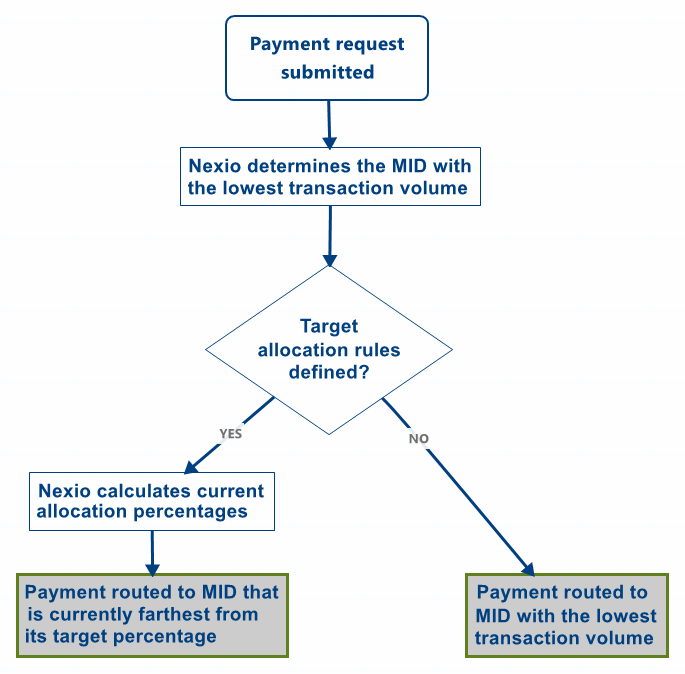What happens after you set up target allocation?
The allocation happens over a calendar month and is based on the current monthly volume of authorized transactions for each target and the monetary amount of the transactions. Allocation is not a back and forth ordering, but instead favors the MID that is currently farthest from the target allocation percentage at the time of the transaction. Therefore, if MID #1 is set for 75% and MID #2 is 25%, the system does not necessarily send four transactions to MID #1 and then one transaction to MID #2. The monetary amount of a transaction (and the amount of previous transactions that month) impact which MID the payment is routed to. It is important to note that there is no current way to split a single transaction across two or more MIDs.
NoteA potential unexpected consequence of this method for allocation may happen if there are multiple small transaction amounts throughout the month and then a single large transaction amount that occurs at the end of the month, resulting in the system using the MID with the lower allocation percentage for that transaction and thus putting that MID well above the expected allocation percentage.
After you configure payment routing by target allocation, the following process happens for each transaction for the transaction currency:
-
A consumer submits payment for a transaction using the target allocation currency.
For example, the USD currency.
-
The Nexio system determines the MID with the lowest monthly gross of authorized transactions (also known as transaction volume).
For example, suppose MID #1, MID #2, and MID #3 can support the currency and MID #4 does not. Only the first 3 are considered.
Then, if MID #1 has a current volume of $4,500, MID #2 is $10,300, and MID #3 is $8,000, the system prioritizes them as follows:
- MID #1
- MID #3
- MID #2
In this case, MID #1 has the lowest transaction volume.
-
The system checks to see if there are target allocation rules that match for this transaction.
If there are not any target allocation rules, the system skips to step 5 in this sequence.
-
The system takes the target allocations and re-sorts the list so that the MID that is farthest away from its target allocation is at the top.
For the following examples, the target allocation is 10% for MID #1, 90% for MID #2, and 0% for MID #3.
Example 1: Current total transaction volume of $5,600.
MID #1 has a current volume of $300 and 10% allocation, so it is at 5.4% and thus 4.6% away from the target for the month. MID #2 has a current volume of $4,800 and 90% allocation, so it is at 85.7% and thus 4.3% away from the target for the month. MID #3 has a current volume of $500 but 0% target allocation, so it is at 8.9%. However, the target is 0%, so no transactions will go to this MID. The MIDs would be prioritized as follows: - MID #1 - MID #2 - (MID #3)
Example 2: Current total transaction volume of $22,800
MID #1 has a current volume of $4,500 and 10% allocation, so it is at 19.7% currently and thus 9.7% over the target for the month. MID #2 has a current volume of $10,300 and 90% allocation, so it is at 45.2% and thus 44.8% away from the target for the month. MID #3 has a current volume of $8,000 but 0% target allocation, so it is at 35.1%. However, the target is 0%, so no transactions will go to this MID. The MIDs would be prioritized as follows: - MID #2 - MID #1 - (MID #3) -
The system routes the payment to the MID at the top of the list.
The following image shows a high-level view of the payment flow from above when you are using target allocation with multiple MIDs.

Target Allocation Flow
Updated 4 months ago
